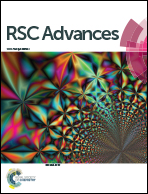Application of zeolite-encapsulated Cu(ii) [H4]salen derived from [H2]salen in oxidative delignification of pulp
Abstract
Since the disclosure that salen complexes were potent low-temperature oxidation catalysts with exceptional selectivity, considerable efforts by our group have focussed on their development towards the efficient catalytic delignification of pulp, principally with environmentally benign oxygenic chemicals. These efforts have resulted in additional developments including the heterogenisation of catalytic systems as well as the hydrogenation for application in catalytic delignification of pulp. Herein, heterogeneous complexes of two ligands: [H2]salen and [H4]salen with copper as a transition metal were synthesized and encapsulated in zeolite cages by the impregnation (IM) and ship-in-a-bottle (SB) method. The resulting complexes were employed as catalysts for oxidative delignification of pulp, using peracetic acid (CH3COOOH) as an oxidant. The observed trends in catalytic activity showed that the encapsulation and hydrogenation of complexes played a key role in the selective delignification of pulp. By encapsulating and hydrogenating the complexes, their spatial separation increased which strongly enhanced the activity of complexes. The encapsulation and hydrogenation of complexes resulted in a significant increase in delignification and properties of pulp. The delignification was dependent on the nature of the complexes. The reasons were investigated by spectroscopic techniques.
![Graphical abstract: Application of zeolite-encapsulated Cu(ii) [H4]salen derived from [H2]salen in oxidative delignification of pulp](/en/Image/Get?imageInfo.ImageType=GA&imageInfo.ImageIdentifier.ManuscriptID=C4RA04175E&imageInfo.ImageIdentifier.Year=2014)

 Please wait while we load your content...
Please wait while we load your content...